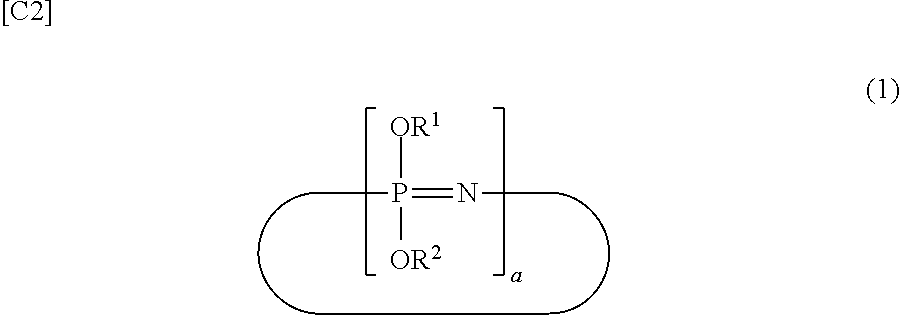Polycarbonate resin composition
a technology of polycarbonate resin and polycarbonate resin, which is applied in the field of polycarbonate resin composition, can solve the problems of reduced thermal stability, corrosion of screw and molding tool in molding equipment, and difficult to respond, and achieve the effects of improving flowability, warping resistance, and impact resistan
- Summary
- Abstract
- Description
- Claims
- Application Information
AI Technical Summary
Benefits of technology
Problems solved by technology
Method used
Image
Examples
examples
[0396]The present invention is described more specifically below through examples. However, the present invention is not limited to or by the following examples, and any modification can be carried out in a range that does not depart from the essential features of the present invention. In the following description, “parts” is on a mass basis, unless specifically indicated otherwise, and represents “mass parts”.
[0397]The following methods were used to evaluate the produced polycarbonate resin compositions.
[Evaluation of the Flame Retardancy (UL 94)]
[0398]The flame retardancy of the particular polycarbonate resin composition was evaluated in accordance with the UL 94 test (Flammability of Plastic Materials for Parts in Devices and Appliances) established by the Underwriters Laboratory (UL) (USA), after conditioning the UL test-qualified test specimen (thickness=0.8 mm, 1.0 mm, or 1.2 mm) obtained by the method described below for 48 hours in a thermostatted chamber at a temperature o...
example 61
[0505]Plate-shaped granules were obtained using a high compression roll-type granulator (“Compacting Machine MS” from Hosokawa-Micron) from a phenoxyphosphazene compound (from Fushimi Pharmaceutical Co., Ltd., product name: Rabitle FP-110, average particle diameter: 325 μm, bulk density: 0.62 g / mL, percentage retained on a sieve with an aperture of 400 μm: 21.5%). This was followed by pulverization using a pulverizer and then classification by screening to obtain a “granular phosphazene compound 1”. This “granular phosphazene compound 1” had a bulk density of 0.63 g / mL and a percentage retained on a sieve with an aperture of 400 μm of 94.7%.
[0506]The percentage retained on a mesh sieve was determined as the percentage (mass %) remaining on the mesh after sieve classification by placing 100 g of the granular phosphazene compound sample on a sieve with an aperture of 400 μm (from Kansai Wire Netting Co., Ltd.) and shaking for 5 minutes using a sieve shaker (AS200 from Retsch).
[0507]Fo...
example 62
[0509]The same phenoxyphosphazene compound as used in Example 61 was granulated using a dry compression granulator (“Roll Press DP” from Seishin Enterprise Co., Ltd.) to obtain a “granular phosphazene compound 2”. This “granular phosphazene compound 2” had a bulk density of 0.35 g / mL and a percentage retained on a sieve with an aperture of 400 μm of 88.1%.
[0510]Then, proceeding as in Example 61, the aromatic polycarbonate resin and the “granular phosphazene compound 2” were fed to the twin-screw extruder, and when this was done sticking to the extruder screw was not seen and production could be carried out without problems.
PUM
| Property | Measurement | Unit |
|---|---|---|
| mass % | aaaaa | aaaaa |
| mass % | aaaaa | aaaaa |
| diameter | aaaaa | aaaaa |
Abstract
Description
Claims
Application Information
 Login to View More
Login to View More - R&D
- Intellectual Property
- Life Sciences
- Materials
- Tech Scout
- Unparalleled Data Quality
- Higher Quality Content
- 60% Fewer Hallucinations
Browse by: Latest US Patents, China's latest patents, Technical Efficacy Thesaurus, Application Domain, Technology Topic, Popular Technical Reports.
© 2025 PatSnap. All rights reserved.Legal|Privacy policy|Modern Slavery Act Transparency Statement|Sitemap|About US| Contact US: help@patsnap.com



